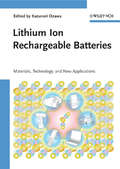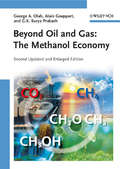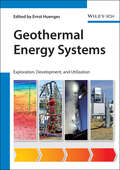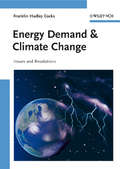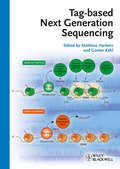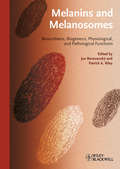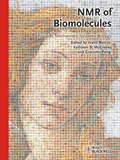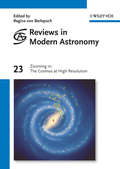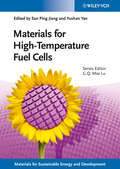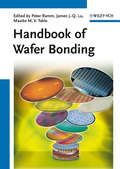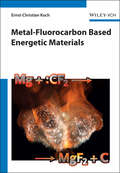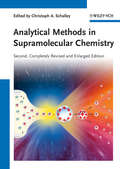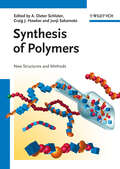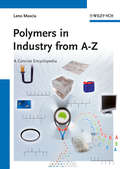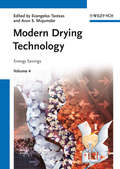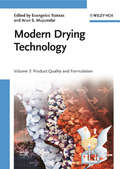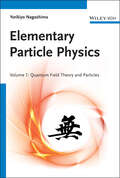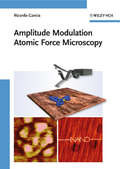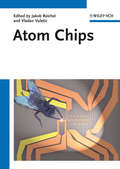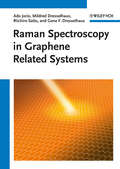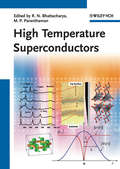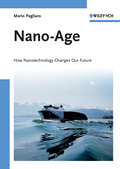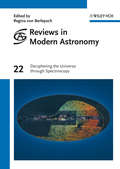- Table View
- List View
Lithium Ion Rechargeable Batteries: Materials, Technology, and New Applications
by Kazunori OzawaStarting out with an introduction to the fundamentals of lithium ion batteries, this book begins by describing in detail the new materials for all four major uses as cathodes, anodes, separators, and electrolytes. It then goes on to address such critical issues as self-discharge and passivation effects, highlighting lithium ion diffusion and its profound effect on a battery's power density, life cycle and safety issues. The monograph concludes with a detailed chapter on lithium ion battery use in hybrid electric vehicles. Invaluable reading for materials scientists, electrochemists, physicists, and those working in the automobile and electrotechnical industries, as well as those working in computer hardware and the semiconductor industry.
Beyond Oil and Gas
by George A. Olah G. K. Prakash Alain GoeppertThe world is currently consuming about 85 million barrels of oil a day, and about two-thirds as much natural gas equivalent, both derived from non-renewable natural sources. In the foreseeable future, our energy needs will come from any available alternate source. Methanol is one such viable alternative, and also offers a convenient solution for efficient energy storage on a large scale.In this updated and enlarged edition, renowned chemists discuss in a clear and readily accessible manner the pros and cons of humankind's current main energy sources, while providing new ways to overcome obstacles.Following an introduction, the authors look at the interrelationship of fuels and energy, and at the extent of our non-renewable fossil fuels. They also discuss the hydrogen economy and its significant shortcomings. The main focus is on the conversion of CO2 from industrial as well as natural sources into liquid methanol and related DME, a diesel fuel substitute that can replace LNG and LPG. The book is rounded off with an optimistic look at future possibilities. A forward-looking and inspiring work that vividly illustrates potential solutions to our energy and environmental problems.
Beyond Oil and Gas: The Methanol Economy
by George A. Olah Alain Goeppert G. K. PrakashThe world is currently consuming about 85 million barrels of oil a day, and about two-thirds as much natural gas equivalent, both derived from non-renewable natural sources. In the foreseeable future, our energy needs will come from any available alternate source. Methanol is one such viable alternative, and also offers a convenient solution for efficient energy storage on a large scale.In this updated and enlarged edition, renowned chemists discuss in a clear and readily accessible manner the pros and cons of humankind's current main energy sources, while providing new ways to overcome obstacles.Following an introduction, the authors look at the interrelationship of fuels and energy, and at the extent of our non-renewable fossil fuels. They also discuss the hydrogen economy and its significant shortcomings. The main focus is on the conversion of CO2 from industrial as well as natural sources into liquid methanol and related DME, a diesel fuel substitute that can replace LNG and LPG. The book is rounded off with an optimistic look at future possibilities. A forward-looking and inspiring work that vividly illustrates potential solutions to our energy and environmental problems.
Geothermal Energy Systems: Exploration, Development, and Utilization
by Ernst HuengesPresenting boundary conditions for the economic and environmental utilization of geothermal technology, this is the first book to provide basic knowledge on the topic in such detail. The editor is the coordinator of the European Geothermic Research Initiative, while the authors are experts for the various geological situations in Europe with high temperature reservoirs in shallow and deep horizons. With its perspectives for R&D in geothermic technology concluding each chapter, this ready reference will be of great value to scientists and decision-makers in research and politics, as well as those giving courses in petroleum engineering, for example.
Energy Demand and Climate Change: Issues and Resolutions
by Franklin Hadley CocksThis scientifically sound, yet easily readable book provides the fundamentals necessary to understand today's energy and climate problems and provides possible answers based on current technology such as solar, water and geothermal power. Moreover, it introduces the reader to new concepts that are already or may soon be realized, such as nuclear fusion or a hydrogen-based economy. Aimed at a wide readership ranging from educated laypeople and students to practitioners in engineering and environmental science.
Tag-based Next Generation Sequencing (Molecular Plant Biology Ser.)
by Matthias Harbers Günter KahlTag-based approaches were originally designed to increase the throughput of capillary sequencing, where concatemers of short sequences were first used in expression profiling. New Next Generation Sequencing methods largely extended the use of tag-based approaches as the tag lengths perfectly match with the short read length of highly parallel sequencing reactions. Tag-based approaches will maintain their important role in life and biomedical science, because longer read lengths are often not required to obtain meaningful data for many applications. Whereas genome re-sequencing and de novo sequencing will benefit from ever more powerful sequencing methods, analytical applications can be performed by tag-based approaches, where the focus shifts from 'sequencing power' to better means of data analysis and visualization for common users. Today Next Generation Sequence data require powerful bioinformatics expertise that has to be converted into easy-to-use data analysis tools. The book's intention is to give an overview on recently developed tag-based approaches along with means of their data analysis together with introductions to Next-Generation Sequencing Methods, protocols and user guides to be an entry for scientists to tag-based approaches for Next Generation Sequencing.
Melanins and Melanosomes: Biosynthesis, Structure, Physiological and Pathological Functions
by Jan Borovansky Patrick A. RileyThe surface pigmentation of vertebrates is controlled by specialized cells able to synthesize a variety of pigments collectively known as melanins. Recent research has shown that melanins are produced not only in the skin but also in many other sites such as the eye, inner ear, muscles, etc., - where they are engaged in some unanticipated roles. The details of the synthetic pathway, the complexities of its regulation and biological significance that have been unravelled in recent research comprise a fascinating story and are of key importance in understanding the nature of diseases, including malignant melanoma one of the most rapidly spreading cancers.
NMR of Biomolecules: Towards Mechanistic Systems Biology
by Ivano Bertini Giacomo Parigi Kathleen S. McGreevyNMR is one of the most powerful methods for imaging of biomolecules. This book is the ultimate NMR guide for researchers in the biomedical community and gives not only background and practical tips but also a forward looking view on the future of NMR in systems biology.
Zooming in: The Cosmos at High Resolution (Reviews in Modern Astronomy #23)
by Regina Von BerlepschHigh resolution is a key element in research in astronomy and cosmology. Advances in instrumentation and new methods are enabling us to constantly make new exciting discoveries, and progress in theoretical modelling allows us to gain a deeper understanding of cosmic physics. One example of this progress in instrumentation and observing strategy have made possible the discovery of a rich population of low-mass planets orbiting solar-type stars (Michel Mayor et al., Karl Schwarzschild Lecture 2010). This 23rd volume in the series Reviews of Modern Astronomy contains 14 invited reviews and highlight contributions presented during the 2010 annual meeting of the Astronomical Society on the topic "Zooming in: The cosmos at high resolution", held in Bonn, Germany, in September 2010.
Modeling and Prediction of Polymer Nanocomposite Properties (Polymer Nano-, Micro- and Macrocomposites)
by Vikas MittalThe book series 'Polymer Nano-, Micro- and Macrocomposites' provides complete and comprehensive information on all important aspects of polymer composite research and development, including, but not limited to synthesis, filler modification, modeling, characterization as well as application and commercialization issues. Each book focuses on a particular topic and gives a balanced in-depth overview of the respective subfi eld of polymer composite science and its relation to industrial applications. With the books the readers obtain dedicated resources with information relevant to their research, thereby helping to save time and money. This book lays the theoretical foundations and emphasizes the close connection between theory and experiment to optimize models and real-life procedures for the various stages of polymer composite development. As such, it covers quantum-mechanical approaches to understand the chemical processes on an atomistic level, molecular mechanics simulations to predict the filler surface dynamics, finite element methods to investigate the macro-mechanical behavior, and thermodynamic models to assess the temperature stability. The whole is rounded off by a look at multiscale models that can simulate properties at various length and time scales in one go - and with predictive accuracy.
Materials for High-Temperature Fuel Cells
by San Ping Jiang Max Lu Yushan YanThe world's ever-growing demand for power has created an urgent need for new efficient and sustainable sources of energy and electricity. Today's consumers of portable electronics also demand devices that not only deliver more power but are also environmentally friendly. Fuel cells are an important alternative energy source, with promise in military, commercial and industrial applications, for example power vehicles and portable devices.A fuel cell is an electrochemical device that directly converts the chemical energy of a fuel into electrical energy. Fuel cells represent the most efficient energy conversion technologies to-date and are an integral part in the new and renewable energy chain (e.g., solar, wind and hydropower). Fuel cells can be classified as either high-temperature or lowtemperature, depending on their operating temperature, and have different materials requirements. This book is dedicated to the study of high temperature fuel cells. In hightemperature fuel cells, the electrolyte materials are ceramic or molten carbonate, while the electrode materials are ceramic or metal (but not precious metal). High operation temperature fuel cells allow internal reforming, promote rapid kinetics with non-precious materials and offer high flexibilities in fuel choice, and are potential and viable candidate to moderate the fast increase in power requirements and to minimize the impact of theincreased power consumption on the environment.'Materials for High Temperature Fuel Cells' is part of the series on Materials for Sustainable Energy and Development edited by Prof. Max Q. Lu. The series covers advances in materials science and innovation for renewable energy, clean use of fossil energy, and greenhouse gas mitigation and associated environmental technologies.
Handbook of Wafer Bonding
by Maaike M. Taklo James Jian-Qiang Lu Peter RammThe focus behind this book on wafer bonding is the fast paced changes in the research and development in three-dimensional (3D) integration, temporary bonding and micro-electro-mechanical systems (MEMS) with new functional layers. Written by authors and edited by a team from microsystems companies and industry-near research organizations, this handbook and reference presents dependable, first-hand information on bonding technologies. Part I sorts the wafer bonding technologies into four categories: Adhesive and Anodic Bonding; Direct Wafer Bonding; Metal Bonding; and Hybrid Metal/Dielectric Bonding. Part II summarizes the key wafer bonding applications developed recently, that is, 3D integration, MEMS, and temporary bonding, to give readers a taste of the significant applications of wafer bonding technologies.This book is aimed at materials scientists, semiconductor physicists, the semiconductor industry, IT engineers, electrical engineers, and libraries.
Metal-Fluorocarbon Based Energetic Materials
by Ernst-Christian KochMetal-Fluorocarbon Based Energetic Materials This exciting new book details all aspects of a major class of pyrolants and elucidates the progress that has been made in the field, covering both the chemistry and applications of these compounds. Written by a pre-eminent authority on the subject from the NATO Munitions Safety Information Analysis Center (MSIAC), it begins with a historical overview of the development of these materials, followed by a thorough discussion of their ignition, combustion and radiative properties. The next section explores the multiple facets of their military and civilian applications, as well as industrial synthetic techniques. The critical importance of the associated hazards, namely sensitivity, stability and aging, are discussed in detail, and the book is rounded off by an examination of the future of this vital and expanding field.The result is a complete guide to the chemistry, manufacture, applications and required safety precautions of pyrolants for both the military and chemical industries.From the preface:“... This book fills a void in the collection of pyrotechnic literature... it will make an excellent reference book that all researchers of pyrolants and energetics must have...” Dr. Bernard E. Douda, Dr. Sara Pliskin, NAVSEA Crane, IN, USA
Analytical Methods in Supramolecular Chemistry
by Christoph A. SchalleyThe second edition of "Analytical Methods in Supramolecular Chemistry" comes in two volumes and covers a broad range of modern methods and techniques now used for investigating supramolecular systems, e. g. NMR spectroscopy, mass spectrometry, extraction methods, crystallography, single molecule spectroscopy, electrochemisty, and many more. In this second edition, tutorial inserts have been introduced, making the book also suitable as supplementary reading for courses on supramolecular chemistry. All chapters have been revised and updated and four new chapters have been added.A must-have handbook for Organic and Analytical Chemists, Spectroscopists, Materials Scientists, and Ph.D. Students in Chemistry.From reviews of the first edition:"This timely book should have its place in laboratories dealing with supramolecular objects. It will be a source of reference for graduatestudents and more experienced researchers and could induce new ideas on the use of techniques other than those usually used in the laboratory."Journal of the American Chemical Society (2008) VOL. 130, NO. 1 doi: 10.1021/ja0769649"The book as a whole or single chapters will stimulate the reader to widen his horizon in chemistry and will help him to have new ideas in his research."Anal Bioanal Chem (2007) 389:2039-2040 DOI: 10.1007/s00216-007-1677-1
Synthesis of Polymers: New Structures and Methods (Materials Science and Technology: A Comprehensive Treatment)
by Junji Sakamoto Craig Hawker Uuml Ter Dieter A. SchlPolymers are huge macromolecules composed of repeating structural units. While polymer in popular usage suggests plastic, the term actually refers to a large class of natural and synthetic materials. Due to the extraordinary range of properties accessible, polymers have come to play an essential and ubiquitous role in everyday life - from plastics and elastomers on the one hand to natural biopolymers such as DNA and proteins on the other hand. The study of polymer science begins with understanding the methods in which these materials are synthesized. Polymer synthesis is a complex procedure and can take place in a variety of ways. This book brings together the "Who is who" of polymer science to give the readers an overview of the large field of polymer synthesis. It is a one-stop reference and a must-have for all Chemists, Polymer Chemists, Chemists in Industry, and Materials Scientists.
Polymers in Industry from A to Z: A Concise Encyclopedia
by Leno MasciaWe are surrounded by polymers: Whether it's to prepare a meal, use computer keyboards and mousepads, or step onto a new playground, you'll encounter a plastic product made of polymers.<P><P> Owing to the extraordinary range of properties accessible in polymeric materials, they play an essential and ubiquitous role in everyday life - from plastics and elastomers on the one hand to natural biopolymers such as DNA and proteins that are essential for life on the other. This desktop and library reference book provides a comprehensive yet concise overview of the materials, manufacture, structure and architecture, properties, processing, and applications of withing the field of polymers. The book offers a unique mix of theory and application, the essential personal reference for anyone studying or working within the field of polymers.
Modern Drying Technology, Energy Savings
by Evangelos Tsotsas Arun S. MujumdarThe five-volume series provides a comprehensive overview of all important aspects of drying technology like computational tools at different scales (Volume 1), modern experimental and analytical techniques (Volume 2), product quality and formulation (Volume 3), energy savings (Volume 4) and process intensification (Volume 5).Based on high-level cutting-edge results contributed by internationally recognized experts in the various treated fields, this book series is the ultimate reference in the area of industrial drying. Located at the intersection of the two main approaches in modern chemical engineering, product engineering and process systems engineering, the series aims at bringing theory into practice in order to improve the quality of high-value dried products, save energy, and cut the costs of drying processes.Volume 4 deals with the reduction of energy demand in various drying processes and areas, highlighting the following topics: Energy analysis of dryers, efficient solid-liquid separation techniques, osmotic dehydration, heat pump assisted drying, zeolite usage, solar drying, drying and heat treatment for solid wood and other biomass sources, and sludge thermal processing. Other Volumes and Sets:Volume 1 - Modern Drying Technology, Computational Tools at Different ScalesVolume 1: Diverse model types for the drying of products and the design of drying processes (short-cut methods, homogenized, pore network, and continuous thermo-mechanical approaches) are treated, along with computational fluid dynamics, population balances, and process systems simulation tools. Emphasis is put on scale transitions. Volume 2 - Modern Drying Technology: Experimental TechniquesVolume 2: Comprises experimental methods used in various industries and in research in order to design and control drying processes, measure moisture and moisture distributions, characterize particulate material and the internal micro-structure of dried products, and investigate the behavior of particle systems in drying equipment. Key topics include acoustic levitation, near-infrared spectral imaging, magnetic resonance imaging, X-ray tomography, and positron emission tracking. Volume 3 - Modern Drying Technology: Product Quality and FormulationVolume 3: Discusses how desired properties of foods, biomaterials, active pharmaceutical ingredients, and fragile aerogels can be preserved during drying, and how spray drying and spray fluidized bed processes can be used for particle formation and formulation. Methods for monitoring product quality, such as process analytical technology, and modeling tools, such as Monte Carlo simulations, discrete particle modeling and neural networks, are presented with real examples from industry and academia. Volume 5 - Process IntensificationVolume 5: Dedicated to process intensification by more efficient distribution and flow of the drying medium, foaming, controlled freezing, and the application of superheated steam, infrared radiation, microwaves, power ultrasound and pulsed electric fields. Process efficiency is treated in conjunction with the quality of sensitive products, such as foods, for a variety of hybrid and combined drying processes. Available in print as 5 Volume Set or as individual volumes. Buy the Set and SAVE 30%!Also available in electronic formats.
Modern Drying Technology, Volume 3: Product Quality and Formulation (Modern Drying Technology)
by Evangelos Tsotsas Arun S. MujumdarThis five-volume series provides a comprehensive overview of all important aspects of modern drying technology, concentrating on the transfer of cutting-edge research results to industrial use. Volume 3 discusses how desired properties of foods, biomaterials, active pharmaceutical ingredients, and fragile aerogels can be preserved during drying, and how spray drying and spray fluidized bed processes can be used for particle formation and formulation. Methods for monitoring product quality, such as process analytical technology, and modeling tools, such as Monte Carlo simulations, discrete particle modeling and neural networks, are presented with real examples from industry and academia.
Elementary Particle Physics: Quantum Field Theory and Particles V1
by Yorikiyo NagashimaMeeting the need for a coherently written and comprehensive compendium combining field theory and particle physics for advanced students and researchers, this book directly links the theory to the experiments. It is clearly divided into two sections covering approaches to field theory and the standard model, and rounded off with numerous useful appendices. A timely volume for high energy and theoretical physicists, as well as astronomers, graduate students and lecturers in physics. Volume 2 concentrates on the main aspects of the Standard Model by addressing its recent developments and future prospects. Furthermore, it gives some thought to intriguing ideas beyond the Standard Model, including the Higgs boson, the neutrino, the concepts of the Grand Unified Theory and supersymmetry, axions, and cosmological developments.
Amplitude Modulation Atomic Force Microscopy
by Ricardo GarcíaFilling a gap in the literature, this book features in-depth discussions on amplitude modulation AFM, providing an overview of the theory, instrumental considerations and applications of the technique in both academia and industry. As such, it includes examples from material science, soft condensed matter, molecular biology, and biophysics, among others. The text is written in such a way as to enable readers from different backgrounds and levels of expertise to find the information suitable for their needs.
Atom Chips
by Jakob Reichel Vladan VuletićThis stimulating discussion of a rapidly developing field is divided into two parts. The first features tutorials in textbook style providing self-contained introductions to the various areas relevant to atom chip research. Part II contains research reviews that provide an integrated account of the current state in an active area of research where atom chips are employed, and explore possible routes of future progress. Depending on the subject, the length of the review and the relative weight of the 'review' and 'outlook' parts vary, since the authors include their own personal view and style in their accounts.
Raman Spectroscopy in Graphene Related Systems
by Gene Dresselhaus Mildred S. Dresselhaus Riichiro Saito Ado JorioRaman spectroscopy is the inelastic scattering of light by matter. Being highly sensitive to the physical and chemical properties of materials, as well as to environmental effects that change these properties, Raman spectroscopy is now evolving into one of the most important tools for nanoscience and nanotechnology.<P><P> In contrast to usual microscopyrelated techniques, the advantages of using light for nanoscience relate toboth experimental and fundamental aspects.
High Temperature Superconductors, 1st Edition
by Raghu N. Bhattacharya M. Parans ParanthamanThis essential reference provides the most comprehensive presentation of state-of-the-art research being conducting worldwide today in this growing field of research and applications. HTS are currently being supported by numerous governmental and industrial initiatives in the USA and Asia and Europe to overcome energy distribution issues and are now being commercialised for power-delivery devices, such as power transmission lines and cables, motors, and generators. Applications in electric utilities include energy-storing devices to help industries avoid dips in electric power, current limiters, and long transmission lines. The technology is particularly thought out for highly-populated and densed areas. Both editors are leading experts in the field from the National Renewable Energy Laboratory and the Oak Ridge National Laboratory. This book can be used as a companion teaching tool, and also as as a research and professional reference.
Nano-Age: How Nanotechnology Changes Our Future
by Mario PagliaroIs the nano-age here to stay or will a bubble soon burst? This thought-provoking page-turner takes a critical glance at how nanotechnology has affected virtually all areas of our lives. From the pharmaceutical industry to energy production and storage, many fields have been truly revolutionized during the nano-age. The internationally renowned author explores the topic in nine entertaining chapters.
Deciphering the Universe through Spectroscopy (Reviews in Modern Astronomy #22)
by Regina Von BerlepschThis 22nd volume in the series contains 15 invited reviews and highlight contributions from outstanding speakers presented during the 2009 annual meeting of the Astronomical Society on the subject of "Deciphering the Universe through Spectroscopy", held in Potsdam, Germany. Topics range from the measurements of magnetic fields on the surface of the sun via detailed measurements of abundances in stellar atmospheres to the kinematics of the universe at its largest scales. The result is a systematic overview of the latest astronomical and cosmological research.
